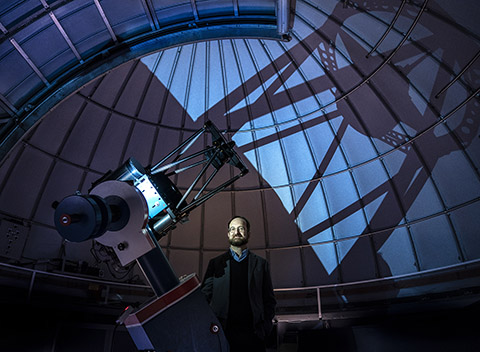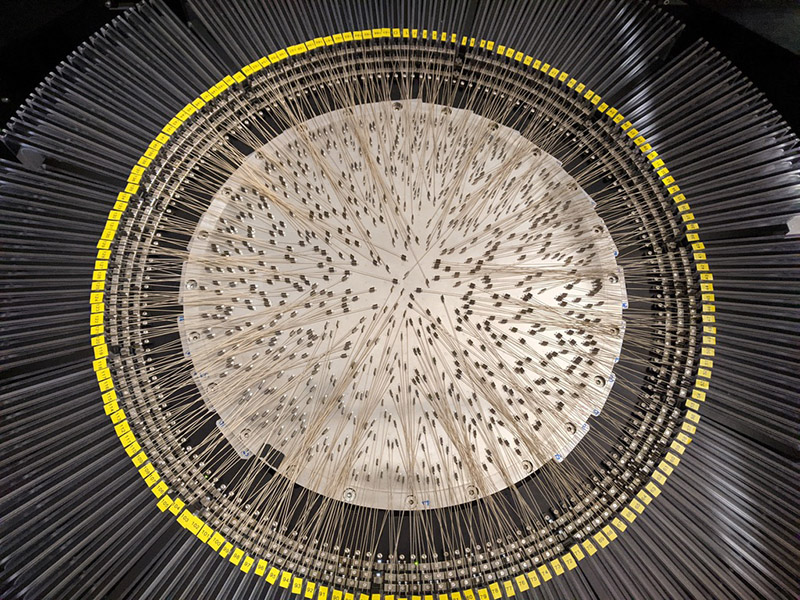
While the vulcano erupts
Catching starlight
In the office of UG astronomer Scott Trager, the video connection to La Palma is on. On his screen, he can watch the ongoing work on the William Herschel Telescope Enhanced Area Velocity Explorer (WEAVE) from at least six different cameras inside the building. Some show machinery that is slowly being put together. Others show people supervising the job.
On that very same island, the Cumbre Vieja volcano is spewing ash into the atmosphere, while lava streams are slowly creeping toward the coast. The telescope itself is at an elevation of 2,725 meters, just above the typical height that the volcanic ash reaches. But still, its dome has been kept closed since the eruption started on September 19.
Impossible
‘Of course, we were very worried our work would become impossible’, Trager says, ‘but even though observations have become very difficult, the work inside the building hasn’t been affected.’
This will be the biggest optical instrument in Dutch astronomical history so far
His worries are no surprise: after all, he is working on what he calls ‘the biggest optical instrument in Dutch astronomical history so far’, on an island where layers of grey ash cover the streets not consumed by lava streams.
The instrument Trager is working on is unique. It makes it possible for the telescope to not only cover an extensive amount of sky, but to also pick up the light of weaker stars. Stars that are even fainter than the ones picked up by Gaia, the space telescope that caused an enormous sensation among astronomers only two years ago.
Glass fibre
Trager wants to do that by using thousands of glass fibre cables, all no thicker than the width of a hair. And that is quite amazing, because the mirrors of telescopes are really no different than your Nikon camera. Use a smaller mirror and you’ll be able to get a wide view, but the resolution will be low. A bigger mirror will focus more light and get you much more detail, but your view will be limited.
To make this work, he needed a telescope with a mirror of around four metres in diameter. ‘In astronomy, that’s a middle-sized telescope’, he says. With that he’d be able to unravel starlight into thousands of separate colours, all of which give him information on the speed and direction in which they travel the Milky Way. However, Trager wants more. He wants to be able to do that for an extensive amount of sky and that was impossible.
Until he realised that he could use a creative solution.
What if he would catch the light using a – sort of – regular mirror? But instead of sending the light straight to the eye, he could send it to a large focal plane, where the light would be in focus over a large area almost half a metre across. That way you create a kind of miniature map of the sky the telescope is aimed at.
Gigantic costs
If he could cover that entire focal plane with single glass fibres that – like internet cables – transport the light from all places on the map to a spectrograph that actually does the measuring, you’d get vital information on the brightness of the star and the colours of the light it emits. And that would tell us how fast it’s moving away or toward us.
It would cost roughly three billion euros and was considered unbuildable
However, cool as the idea might be, the cost would be gigantic, Trager says. ‘For the William Herschel Telescope we would need nearly seven hundred thousand fibres to cover the full focal plane. As we can put about a thousand fibres into a single spectrograph, that means we would need nearly seven hundred spectrographs to capture the light from all of these fibres at once.’
That would result in one big problem: it would cost roughly three billion euros. And so it was considered unbuildable.
La Palma
But then, in 2010, Trager met the new director of the La Palma telescope, which needed an update after thirty years. And La Palma happened to be the perfect place to build a revolutionary instrument like this one. Not only because of its telescope’s 4.2 metre mirror, but also because of its clear skies and steady winds.
‘When winds change directions, because of buildings or other structures, that messes up the telescopic image’, Trager explains. ‘For the best measurements, we need a stable wind from one direction and that is to be found at the top of mountains, and close to the sea.’ Just like at the observatory on La Palma.
Trager got talking with Oxford astrophysicist Gavin Dalton, who had a similar idea. ‘His design was less complicated and less expensive than mine.’ The two astronomers were able to fit their plans together.
Instead of covering the entire focal plane – as was Trager’s initial idea – WEAVE is now focusing only on relevant parts: where stars are expected to show up. Two robots will now put the fibres in place on the exact locations where stars are situated on the miniature map. ‘This way, we’ll be able to vastly reduce the number of fibres needed’, Trager says. An extra bonus: they will have fewer excess data – like measurements of a dark sky.

Silent
So now the unbuildable instrument is finally being built. WEAVE looks like a piece of lace or a loom, using 950 fibre cables, each focusing on its very own single star. Two cameras, each with a resolution of 12,000 by 6,000 pixels, gather the resulting spectra.
Two cryostats containing liquid nitrogen cool the digital cameras down to make them more sensitive and almost completely silent. While measurements are being made, the two robots are busy readying a second set of 950 fibre cables. After they’re done, the plates switch places and the process starts all over again.
Until now we haven’t built an optical instrument that was even half as big
And it is almost finished. Except for the testing phase, which was first delayed by the pandemic and is delayed again by the volcano spewing its ash into the atmosphere.
Uncertain
‘We still need to check if starlight can actually pass through the whole system’, Trager says. ‘And once we’re convinced we can do that, we need to check whether the robots can put the fibres in the places we think they need to go.’ However, Trager is pretty confident about that: ‘We have already done 350.000 moves, so we know very well. But we still need to check.’
But for over a month now, the dome of the telescope has been kept closed, because of the risk of getting ash into the equipment. ‘We’re working on completing the integration and testing of all components’, says Trager. But the danger of eruptions still makes things uncertain. ‘We don’t know if we’ll be able to start observing starlight at the end of February as planned.’
So Trager will need some more patience. But then he’ll be able to finally see the results of his big plan. ‘I’m really looking forward to it. Until now we haven’t built an optical instrument that was even half as big. And I’m convinced in the end it will be worth it.’
Colours of light
For Trager and his team, both the position and movement of the stars are of interest, because they contain information on how the galaxy evolves and how the Milky Way was formed.
Astronomers can determine the speed and direction with which a star is travelling through space by looking at the colours of the light they send to Earth. When a star is moving away from us, the light waves become elongated and will have a lower frequency – just like the sound of a moped or a police car with the sirens on will sound lower.
Astronomers call this a red shift, because the light appears redder than it would be if the star wasn’t moving. When a star moves towards us the opposite happens. The light waves get compressed, which is called a blue shift. And the faster light goes, the more the light waves get compressed or stretched out, and the bigger the red or blue shift.